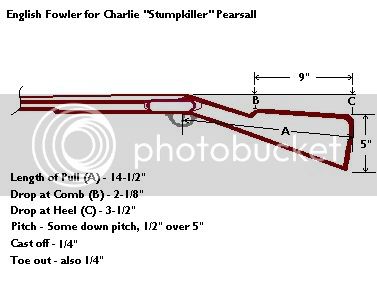mattybock said:
I own only 3 muzzleloaders and I'll tolerate alot of stuff that is not historically accurate.
What can you not tolerate?
I hate modern shapes on reproduction guns, especially so with stocks. Seeing a 'kentucky' rifle with a 2.25" drop at the heel makes me cringe. Also, not a fan of case color hardening. I'm much happier with russetting/browning.
If 2.25" drop is something the makes you cringe then you apparently have a basic lack of understanding of actual traditional MLs and have not actually used one much. I mean an actual TRADITIONAL ML not something cranked out in a factory someplace.
That is one of my pet peeves. People not even understanding what a traditional ML is or how its SUPPOSED to look then stating they don't like a feature common to most traditional MLs.
Casehardening for example.
If you walked into the Hawken Shop in 1840 and bought a "mountain" rifle it would surely have casehardened in colors parts, the breech and lock trigger bar maybe the TG and BP. Why? Because this is the right way to finish them for durability and casehardened without colors is UGLY unless its then polished. In the 1770s the colors were generally (we think) polished off. But this fell from favor and the colors were left on in most cases by 1800 or so. Locks were not browned. So unless the gun has seen a lot of service brown is not traditional for locks andan even brown across the parts even less so. Barrels were browned or blued or left white.
But people look at a rifle like this one.
Then since they do not understand how it was made or how it looked when new they cannot make the leap to see it as new. Since the lock is somewhat corroded (caps of the time produced very aggressive fouling much like Pyrodex today) the metal finish gone and other metal parts have been rusted to some extent they think it was browned when new. The barrel may have been but the lockplate, trigger guard, buttplate and breech parts were surely case hardened. This from information on other Hawkens. Taking this one apart to see if there is color on the reverse of the lockplate is not something the Montana Historical Society would want since its original owner was Jim Bridger.
Color casehardening will fade pretty rapidly either from wear or exposure to the elements. sunlight for example. Many BL guns with such colors have them coated with an lacquer to help preserve them.
Finally what someone likes has nothing to do with what is historically correct. What people see as HC today, such as aged firearms, powder horns etc., is their erroneous PERCEPTION based on looking at 150-250 year old USED firearms. They get so involved with the "look" that they lose sight of what the firearm really WAS when it was new or in actual use. In their minds there is a fallacious image of what a Kentucky is supposed to look like in metal and wood finish. They get used to looking a Model 700 bolt action stocks and think a Hawken should have the same drop and pitch. This shows a fundamental lack of understanding of traditional arms.
This "aged gun" craze (its actually more of a cult) reminds me of some outlaws circa 1880-1900 (could have been the Wild Bunch don't recall the people) who were now back in the money after a "job" and
they were going to get rid of their "shiney" (finish worn off) guns and get new ones that looked better. Today people rub the finish off to make the gun look used. Its wannabe stuff, they don't use the gun much but they "wanna" have it look old timey. So they take a rifle they would carry to a Rev-War era re-enactment and put age on it equal to 40-50 years of use so the gun now does not look like it would have in 1776 or 1780 it looks as it did after being in use for 60 years or more so the artificially (and generally inaccurately) aged item supposedly from 1770s now looks like it would have during the Mexican War of the 1840s. Perhaps after the original owners grandson had dragged it around because while he was allowed to hunt with it it was too heavy for him to carry at 8-10 years old. I once had a man born in the 1880s tell me of wearing a part of the stock away on the shotgun he was given to hunt with as a kid in this very manner. He said it was too heavy to carry and he would lay down to shoot it.
So modern traditional arms are intentionally damaged because someone "likes" it that way and thinks it looks cool even though it has little to do with how the gun looked during most of its service life. Given the number of Rev-war rifle converted to percussion (probably in the 1830s-40s) many of these guns, by now bored for shot, were in use for 100 years or more. How they look NOW has little to do with how they looked even after 10 years of service. But people can't or don't want to see them as they really were.
Dan






